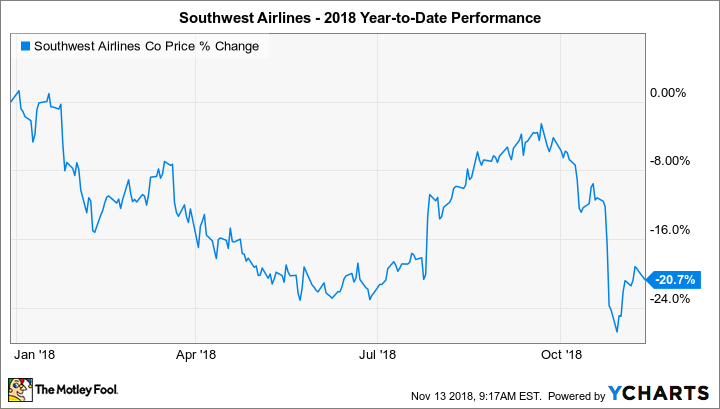The airline industry has had an exceptional decade, with major airlines across the industry becoming more profitable than ever before in their history. Southwest Airlines (LUV -0.91%) has always done a better job of staying profitable than its competitors, and amid massive consolidation among airline companies, the Texas-based giant has become one of four powerhouses in the industry.
Yet despite its long-term success, Southwest has had a tough time during 2018. With cost pressures hitting the airline harder than some of its peers, Southwest has some investors worried about whether it can maintain its leadership role in the industry. That's played a key role in causing the stock to drop more than 20% so far this year, but CEO Gary Kelly has a long track record of success that bullish investors think will make Southwest a long-term winner again.
Southwest's flight plan for 2018
Coming into 2018, investors had every reason to think that Southwest would have an extremely good year. The airline had a strategic plan that included a number of moves to boost efficiency, including the retirement of some of its oldest aircraft among its fleet of 737s and increased utilization of its new reservation system from 2017. In addition, tax reform promised to be a huge boon to Southwest, as it not only reduced the amount of tax it had to pay on its profits but also provided some great incentives for the fleet modernization efforts that the airline was in the process of doing anyway.
Yet it didn't take long for Southwest to fall behind some of its peers. In late March, the airline cut its guidance for the key revenue-per-available-seat-mile metric, predicting only flat performance after initially expecting gains of 1% to 2% during the first quarter of 2018. The fact that rivals Delta Air Lines (DAL 0.43%) and United Continental Holdings (UAL 0.17%) had boosted their unit-revenue projections made Southwest stand out in a bad way.
Stats on Southwest Airlines
|
Revenue, Past 12 Months |
$21.54 billion |
|
One-Year Revenue Growth |
2.8% |
|
Net Income, Past 12 Months |
$3.69 billion |
|
One-Year Net Income Growth |
73% |
Source: Southwest Airlines.
Southwest also faced an unprecedented disaster. For the first time in its nearly half-century of operations, one of Southwest's passengers died aboard a flight due to an engine malfunction. The high-profile event likely contributed to the airline's lackluster performance during the first half of the year, as it chose to halt advertising and promotional activities in the aftermath of the accident.
Looking to gain altitude
Yet difficult times haven't stopped Southwest from pursuing ambitions. The airline has huge aspirations to expand its route map, with expectations to add more international routes in the Caribbean, Mexico, Central America, and even South America. Moreover, plans to add Hawaii to the list of Southwest's destinations within the next year have generated a lot of attention in the industry.
Southwest also is trying to be smart with its fee-generating efforts. In August, the company said it would boost flat $15 fees for early check-in to as much as $25 on some routes. By matching demand for certain routes, the move ensures that an ideal number of passengers will use the service, preserving its value.

Image source: Southwest Airlines.
The most recent results from Southwest suggest that its strategy is starting to work. In the third quarter, revenue rose 5% on a 1.2% rise in unit revenue. Costs were up 3% from year-earlier figures, but tax savings helped boost Southwest's bottom line by almost 17%. The CEO also pointed to stock buybacks in cutting outstanding share counts and boosting per-share earnings figures as healthy for the company's investors overall.
Can Southwest fly higher?
Two main issues face Southwest in its quest for long-term success. First, the airline needs to work to boost productivity. Potential solutions include substituting larger late-model 737 orders to increase capacity for busier routes, as well as looking at additional initiatives to boost sales overall. Second, figuring out how to deal with volatile fuel costs will be crucial, especially given the drag that a less-than-ideal hedging strategy produced in recent years.
All in all, Southwest has done a good job throughout its history in addressing the challenges of a tough industry. With many airlines still flying high, Southwest has an opportunity to reassert its winning ways and catch up to some of its better-performing competitors.






